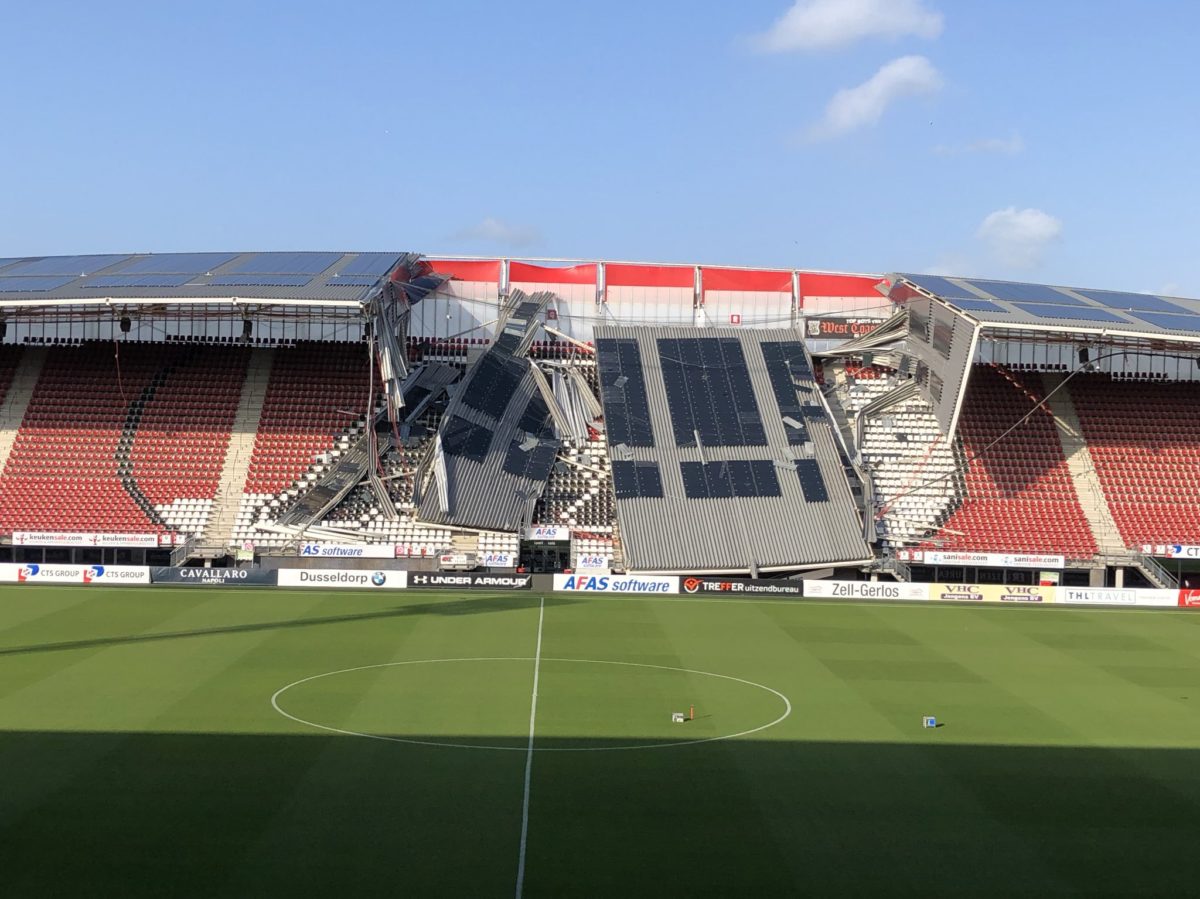The news has been plastered across Netherlands and international media and has caused a sensation. A large portion of the roof on one stand at football club AZ Alkmaar’s stadium collapsed on Saturday as strong winds hit the city of Alkmaar.
Fortunately the stadium was empty at the time as the football team were playing on the road at RKC Waalwijk and nobody was hurt. The team’s general manager Robert Eenhoorn announced a thorough investigation of the matter has been launched, and it was too early to say what may have caused the collapse.
The weight of a Hanergy thin film rooftop solar system on top of the stand may have been a factor in the incident, according to Andries Broersma, owner of Ingenieursbureau Broersma BV and chief engineer for the design of the 2006-built stadium. Broersma told Dutch national TV channel NOS the incident may have been caused by a combination of factors also including poorly attached steel pipes and strong winds.
“It is strange that AZ Alkmaar has laid the solar panels without asking us if the roof could handle it,” the engineer said, referring to the fact the Hanergy system was installed in 2015, almost a decade after the stadium was built.
Solar unlikely to be the cause
Thorsten Kray, head of the PV wind loading department at Germany’s Institut für Industrieaerodynamik GmbH, took a different view.
“I have had a quick look on the news feed,” he told pv magazine. “And, I absolutely do not believe that the solar panels are the root cause of the wind-related failure. If the structural design calculations were carried out properly, [and] taking the dead load of the solar panels into account, PV panels cannot be considered the cause.”
Kray cited numerous scientific publications about flush-mounted PV panels which demonstrate roof-parallel solar does not increase static wind load on rooftops.
“Such grandstand roofs as the Alkmaar [stadium] are likely to be prone to resonant dynamic wind effects and [are] usually subject to wind tunnel study, in a boundary layer wind tunnel,” said the expert. “If I was in charge with this investigation, I would check on this first.”
Kray said, theoretically the mass of the solar panels would change the normal frequencies of the structure affecting the dynamic wind load of the roof, adding: “However, this is something that should have been checked when adding the solar panels to the roof, which typically would be the responsibility of the structural engineer in charge for the stadium roof. In brief, somebody must have given permission to add the solar panels to the roof and that person certainly was not the mounting system manufacturer, installer or EPC [engineering, procurement and construction services provider].”
A spokesperson for Hanergy told pv magazine: “Hanergy Europe has recently learnt of the storm damage on 10 August 2019 to a part of the roof in the AZ-football stadium in Alkmaar, the Netherlands, on which MiaSole PV modules have been installed since 2015.
This content is protected by copyright and may not be reused. If you want to cooperate with us and would like to reuse some of our content, please contact: editors@pv-magazine.com.




3 comments
By submitting this form you agree to pv magazine using your data for the purposes of publishing your comment.
Your personal data will only be disclosed or otherwise transmitted to third parties for the purposes of spam filtering or if this is necessary for technical maintenance of the website. Any other transfer to third parties will not take place unless this is justified on the basis of applicable data protection regulations or if pv magazine is legally obliged to do so.
You may revoke this consent at any time with effect for the future, in which case your personal data will be deleted immediately. Otherwise, your data will be deleted if pv magazine has processed your request or the purpose of data storage is fulfilled.
Further information on data privacy can be found in our Data Protection Policy.